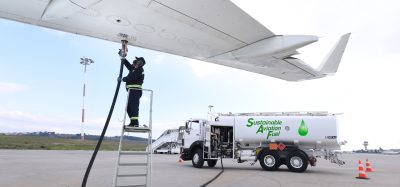FAME / Airport aviation fuelling
- Like
- Digg
- Del
- Tumblr
- VKontakte
- Buffer
- Love This
- Odnoklassniki
- Meneame
- Blogger
- Amazon
- Yahoo Mail
- Gmail
- AOL
- Newsvine
- HackerNews
- Evernote
- MySpace
- Mail.ru
- Viadeo
- Line
- Comments
- Yummly
- SMS
- Viber
- Telegram
- Subscribe
- Skype
- Facebook Messenger
- Kakao
- LiveJournal
- Yammer
- Edgar
- Fintel
- Mix
- Instapaper
- Copy Link
Posted: 11 December 2009 | Michel Baljet, Assistant Director, Technical Fuel Services, IATA | No comments yet
In an effort to reduce emissions and greenhouse gases, and to increase fuel supply security, biofuel mandates have become increasingly prevalent. Existing legislation includes Directive 2003/30/EC of the European Parliament, the Energy Independence and Security Act (US), and the Renewable Transport Fuel Obligation (US). In addition, Canadian provincial governments have legislation planned. Mandates such as these have made biodiesel and ethanol two of the most widely accepted biofuels in the world today. Unfortunately, biodiesel and jet fuel can be incompatible, and cross-contamination is a threat facing the aviation industry.
In an effort to reduce emissions and greenhouse gases, and to increase fuel supply security, biofuel mandates have become increasingly prevalent. Existing legislation includes Directive 2003/30/EC of the European Parliament, the Energy Independence and Security Act (US), and the Renewable Transport Fuel Obligation (US). In addition, Canadian provincial governments have legislation planned. Mandates such as these have made biodiesel and ethanol two of the most widely accepted biofuels in the world today. Unfortunately, biodiesel and jet fuel can be incompatible, and cross-contamination is a threat facing the aviation industry.
Biodiesel is manufactured using a chemical process called transesterification (see Figure 1 opposite). Manufacturers react methanol with an oil (triglyceride) such as vegetable oil, animal fat or used cooking oil to produce Fatty Acid Methyl Ester (FAME) and glycerol. The ester is called biodiesel and has properties similar to petroleum diesel.
Today’s biodiesel is typically blended with petroleum diesel. The blends are commonly referred to as BX, where X designates the volume percent of FAME. For example, B5 contains 5% FAME and B10 contains 10% FAME. Although most engine manufacturers have approved the use of these blends for on-road applications, biodiesel has not been sufficiently tested in aircraft applications.
Certain jet fuel specifications limit the contamination to five parts per million (1 ppm = one-millionth of a litre per litre) FAME. Worldwide, multi-product supply systems such as pipelines, trucks, trains and ships, have a long history of successfully sharing transportation fuels and fluids, using time-honoured protective measures that avoid cross-contamination. Unfortunately, the permitted threshold of biodiesel is much too low to be ensured using these techniques.
While many people familiar with aviation do not believe that low-level biodiesel contamination of jet fuel is a major hazard, there is concern over some of the properties of biodiesel, namely the thermal stability and the behavior at low temperatures. Some FAMEs are more stable than others, depending on the source of oil. Moreover, “B100” solidifies at temperatures where jet fuel must remain liquid. These reasons, combined with undocumented performance in jet engines, are why the aviation engine manufacturers do not want biodiesel in the jet fuel.
While the 5 ppm limit of FAME is already in the Def Stan 91-91, it has not yet been incorporated into the other major jet specification, ASTM D1655. This limit is extremely low, which poses some large operational challenges. For example, one litre of B5 can render 10,000 litres of jet fuel off specification!
Another property of FAME that makes it difficult to deal with is its ‘surface activity.’ Simply put, FAME has a tendency to ‘stick’ to surfaces such as walls, tanks, and pipes. It can come into contact with other grades of fuel in shared lines, at times redistributing itself in this passing fuel. This process can take place in jetty lines, loading arms, even sampling cans, calibration equipment and gloves. In any situation where jet and diesel come into contact there is a potential for FAME contamination due to this surface activity. This threat cannot be overstated, since in general jet fuel follows diesel (which may contain biodiesel) through pipeline systems. It is important to understand the risk of contamination at every single handling step, from the refinery to the airport.
The industry is used to dealing with very tight control levels and does so by optimising product sequencing, using specific cleaning procedures and defining appropriate interfaces. The introduction of ultra low Sulphur products required some updates to these procedures, but this 5 ppm FAME limit is an order of magnitude more difficult to manage. Sulphur is already present in both diesel and jet and is not surface active like FAME. There is also absolutely no potential to come into contact with pure Sulphur, while there can be with pure FAME. Compared with Sulphur limits, the 5 ppm FAME limit is 400 to 1000 times more strict.
In practice, all this means is that biodiesel and jet cannot come into contact without jeopardising specification compliance. Due to the large (and increasing) volumes of biodiesel being consumed in certain parts of the world, cross-contamination presents a major challenge. On a refinery level, this means building a completely new infrastructure for FAME. For tanker ships it requires intermediate non-biodiesel cargos and/or extra cleaning. In pipelines, it has the potential to double the amount of interface to be brought back to the refineries for reprocessing. Having to truck this volume back to the refinery is detrimental to the environment, which negates one of the prime reasons biodiesel was introduced in the first place.
Another challenge to the 5 ppm limit is the ability to test for it. Since 5 ppm is barely detectable, only very sophisticated instruments can do the job. A specially configured gas chromatograph is used as one of the industry accepted methods for detection. Development of this test method was coordinated by the Energy Institute in record time, however it is difficult and expensive, and there are only a few labs in the world that perform it. More work is underway on other methods. One of these new methods, based upon Infra-Red technology (FTIR), might become a good field method if a higher FAME limit is introduced. One new instrument can measure FAME as low as 30 ppm and would be feasible if a higher FAME limit is approved.
The industry came together (in March 2009) to address all the above issues and to determine a workable limit of FAME contamination that would not impact the safety of jet fuel and would minimise cost. It was agreed that a maximum limit of 100 ppm FAME in jet fuel was a reasonable target. As with everything in the jet fuel industry, testing is to be done at four times the limit, to ensure that a higher than approved level of contamination would still allow safe aircraft operation.
Testing by the oil companies, done at 400 ppm FAME, has indicated no noticeable effect on fuel properties. However, engine manufacturers and airframe manufacturers have requested additional bench tests and engine tests to confirm that fuel with up to 100 ppm FAME is still fit for purpose. This US $2 million programme is led by the Energy Institute and is sponsored by oil companies, pipeline companies, government ministries, biofuel producers, and military agencies. The engine endurance test started at the beginning of September 2009 and has completed several hundred cycles. It is expected that the work will be finished by mid-January 2010.
Concurrently, the aviation industry is working on an emergency limit of 30 ppm. This limit would stay in place until the 100 ppm approval is granted and implies that the aircraft having between 5-30 ppm FAME does not have to be diverted to the closest airport, but can fly to its final destination. Of course mitigation plans should start immediately to prevent long exposures to these levels. In general, a maximum of two uplifts will be allowed. This protocol is meant to minimise the impact for the passengers. Airworthiness authorities such as FAA, CAA and EASA have approved this approach, however there is no final agreement from some engine and airframe manufacturers.
It is clear that the current level of 5 ppm max FAME will be very difficult to manage. Not only does it add a lot of cost to the fuel, but it also implies a constant threat of airport closures. Experience over the last year has shown that this threat is real. A number of airports were in that position or very close to it.
Dilution with FAME-free product is an effective means of getting the fuel to meet specification. At refineries and intermediate terminals dilution is a straightforward process, but it is very difficult at airports. Airport systems are not set up to mix products. Large airports pose additional challenges because the fuel infrastructure is set up to be supplied from a one-way pipeline. Since reversing the flow in a pipeline is nearly impossible, the only realistic option is to drain the tank and replace with a new product. This means that the product has to be removed truck by truck. As an example, Paris Charles De Gaulle would require 700 trucks to remove one day of stock. Such an activity would release a huge additional amount of CO2.
It is clearly in the best interest of passengers, and the aviation industry as a whole, to approve the higher FAME ppm limits as quickly as possible. Who would have thought that the introduction of a green diesel fuel could potentially keep you waiting in the airport on your way to your next vacation or business meeting?


Transesterification of triglyceride with methanol

















